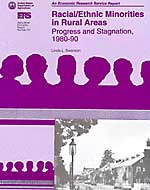Racial/Ethnic Minorities in Rural Areas: Progress and Stagnation
- by Linda L. Swanson
- 8/1/1996
Overview
Rural minorities lag behind rural Whites and urban minorities on many crucial economic and social measures. This report examines rural Black, Hispanic, Native American, and Asian and Pacific Islander populations and their economic well-being in the 1980's, an economically difficult decade for rural areas. Results show minimal minority progress as measured by changes in occupation, income, and poverty rates. However, the type and speed of progress was quite different among minority groups and between men and women of the same minority group. Results showed considerable diversity among groups in the characteristics that were associated with poor economic outcomes.
Download
-
Entire report
Download PDF -
Abstract, Acknowledgments, Contents, and Summary
Download PDF -
Introduction
Download PDF -
Education and Rural Minority Job Opportunities
Download PDF -
The Ethnic Dimension of Persistent Poverty in Rural and Small-Town Areas
Download PDF -
Rural Child Poverty and the Role of Family Structure
Download PDF -
Age and Family Structure, by Race/Ethnicity and Place of Residence
Download PDF -
Increasing Black-White Separation in the Plantation South, 1970-90
Download PDF -
Trends in Occupational Status Among Rural Southern Blacks
Download PDF -
Education and the Economic Status of Blacks
Download PDF -
Hispanics in Rural America
Download PDF -
American Indians
Download PDF -
Appendices
Download PDF
We’d welcome your feedback!
Would you be willing to answer a few quick questions about your experience?

